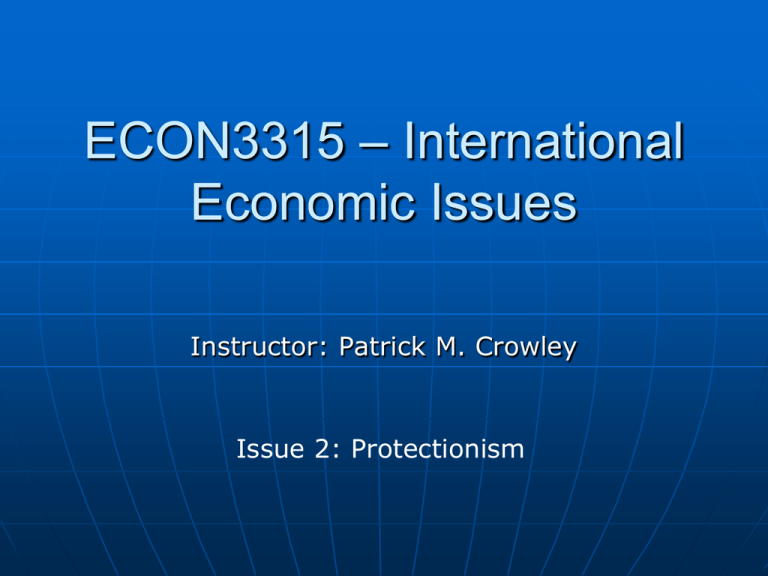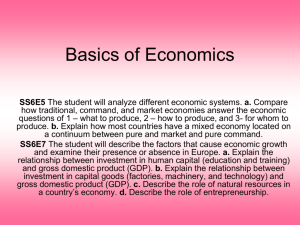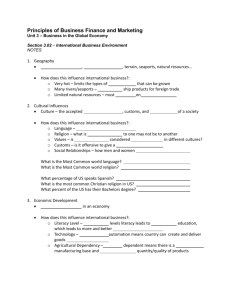Issue 2
advertisement

ECON3315 – International Economic Issues Instructor: Patrick M. Crowley Issue 2: Protectionism Overview Patterns of trade: review Protectionism Analysis of tariffs and quotas US quotas US tariffs Protectionism in the rest of the world Multilateralism vs bilateralism Trade diversion vs trade creation Case studies Patterns of trade Recapping from last time… Who you trade with is in theory determined by the Gravity model – closer and larger they are, more you trade with them What you trade is determined by comparative advantage In theory comparative advantage depends on: - labor productivity (Ricardo) - Factor endowments (H-O) - Natural resources - Economies of scale (Krugman) Many countries (including the US) are not willing to let free trade decide what they produce, so resort to “protectionism” How has trade changed over time? Protectionism Protectionism can take many forms, the most common of which are: Tariffs – placing a “tax” on an import (e.g. steel) Quotas – limiting the amount of product that can be imported (e.g. autos) Voluntary export restraints – equivalent to quotas, but agreed to by exporting country National standards – deciding on certain standards (e.g. mobile phones) Government procurement rules – these often favor domestic producers (e.g. Malaysia) In most cases these measures i) hurt the consumer, ii) benefit the domestic producer and iii) limit competition. Analysis of tariffs and quotas Most US tariffs and quotas are on selected goods and services – analysis by Jacob Viner in 1950s A tariff of x% is equivalent to an import quota of m as the quota will raise prices Analysis of tariffs and quotas Before protectionist measure, M=Q0-S0, price = P0, domestic producers supply S0 Tariff raises prices by (P1-P0) – equivalent quota is Mbar Loss of consumer surplus = A+B+C+D Gain in producer surplus = A Gain in government revenue = C Net welfare loss(tariff)=A+C-(A+B+C+D) = -(B+D) Net welfare loss(quota)=A-(A+B+C+D) =-(B+C+D) Transfer to foreigners(quota) = C Global loss(quota) = -(B+D) Analysis of tariffs and quotas That is the end of the story if the country is small…but US is not small! If the country is large ( - like the US, losses can be greater)… Analysis of tariffs and quotas With free trade, equilibrium is at P0 and M0 When US adopts protectionist measure, foreign suppliers gain “rents” of C+E (E represents extra profit from being able to charge higher prices to other countries) But loss now also includes producer surplus loss E and F, as world prices change So net loss for foreign suppliers=(C+E)-(E+F)=CF So C is the gain in profits from higher prices in the US, and F is the “deadweight loss” (loss in efficiency) Analysis of tariffs and quotas Summary of analysis for selected products: Tariffs and quotas used by the US Autos – VERs from Japan Dairy & sugar – quotas Steel & clothing – VER Increased prices in the US for autos from Japan also allowed European auto makers to raise prices Quota rents are earned by foreign firms Likely that foreign welfare is increased by quotas Loss to US is roughly 0.75% of GDP Also could be that foreign firms sell more products of higher quality to remain competitive – that means effective protection of US firms actually lower, and also that less quota rents gained by foreign firms US quotas For both sugar and textiles, foreign countries appear to have losses from the US quotas Quotas are often allocated to different countries, and can often favor the less efficient producers (e.g. steel) VERs usually require licenses to be distributed to foreign firms, and this can also mean efficiency losses Many foreign auto firms set up plants in the US specifically to avoid the quotas applied to imports US tariffs Average US tariff<2%, but tariffs on industrial products low (0.8%), and high on consumer goods (10.5%) Shoes and clothes bring in roughly 50% of tariff revenues US tariffs Tariffs Higher on cheaper goods than on luxuries – clearly depends where the competition is, and the effectiveness of lobbying Tariffs Tariffs paid on goods imported from countries where US already has a trade pact are low For others, the rates can be quite high Protectionism in the rest of the world Developing countries, in particular, have very high tariff rates Because of high Indian tariff rates, Nepal (north of India) exports more to the US than it does to India EU as well has many restrictive tariffs and quotas But benefits of free trade should make it advantageous to eliminate protectionist measures, irrespective of what other countries do Protectionism in the rest of the world Multilateralism vs bilateralism The General agreement on trade and tariffs (GATT) originally had as it’s aims the elimination of tariffs and quotas on a multilateral basis. The GATT is now part of the WTO. Many countries became frustrated though with the slow pace so negotiated bilteral free trade agreements In Europe this happened in the 1990s and has given rise to a “spaghetti bowl” effect In Asia this is currently in train and has been labelled a “noodle bowl” effect US has trade agreements with Australia, Bahrain, Chile, Columbia, Israel, Jordan, Malaysia, Morocco, Oman, Panama, Peru, Singapore Multilateralism vs bilateralism Trade creation vs trade diversion If a bilateral agreement is made, then lower prices for g&s that the countries trade Leads to inefficiencies if the lowest cost provider is not one of these countries – known as “trade diversion” Leads to more trade between the countries which is known as “trade creation” In a way these bilateral trade deals are protectionist, but depending on the amount of trade diversion Case studies Steel Sugar





